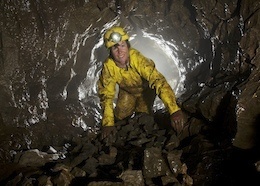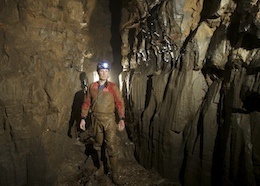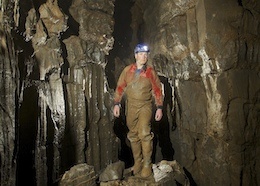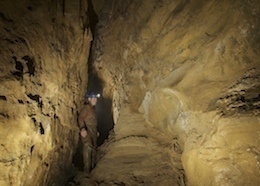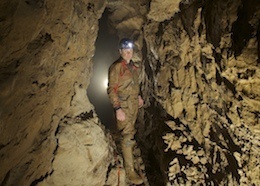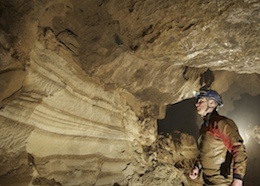Overview
Ogof Gwynt yr Eira (meaning Cave Of The Snowy Wind) is a rarely visited, but fairly extensive cave.
The cave has two distinct sections. The first section descends to a streamway and sump series via the two extremely loose Drop the Dead Donkey SRT Pitches. The second section leads through some muddy, tight passages and down more climbs into a fine, tall canyon passage - The Road to Nowhere, that ends at a muddy choke.
The water in the cave is thought to resurge at Llygad Llwchwr which over 6km distant and 260m lower in elevation.Length 523m
Altitude 487m
Grid SN 73155 18522
History
The cave has been dug since 1985 by the South Wales C.C. The major extensions being found in 1995 and 1996.
Location
The cave is located in the base of a cliff in a prominent shakehole 300m south of the upper Herbert's Quarry car park and just a few metres to the west of the Brynamman to Llangadog road.Western Black Mountain Google map showing the location of Ogof Gwynt Yr Eira and other caves in the area.
Location map - click marker to show entrance photo
Access
No known access restrictions, but please replace the cover over the entrance shaft after exiting.
Description
The covered entrance to Ogof Gwynt Yr Eira is located at the base of a exposed rock face in the north of the shakehole, where a small stream sinks in wet weather. Spits allow a handline to be rigged to assist the climb down the 5 metre deep entrance shaft, which has much loose rock in the walls, so great care must be taken. At the bottom a low crawl heads off to reach the remains of an old gate after about 10 metres. Passing through the gate feet first the top of an 8 metre shaft is reached, where hangers and an old handline are in place on the top section of the shaft that can be free-climbed. Once at the bottom a short drop leads to a section of boulder choke, through which runs a scaffold frame that is suspended via steel cables from above. Great care should be taken through this area. Finally a short climb down leads to a gently sloping passage that heads past the entry point to Alaska on the right before shortly arriving at the top of the Drop The Dead Donkey pitches.Alaska starts as a squeeze through mud covered boulders to enter a chamber with some dried mud formations. In this area passages to the right lead into a series of interconnecting and ascending muddy passages that all eventually close down. Keeping to the left going through Alaska leads to a muddy 3m deep pot that can be climbed down to reach a rift heading left and right. To the left is the bigger rift that leads to passage that closes down quite soon. The way on is through a squeeze in the rift to the right which soon opens into a taller and wider rift. Progress is then made over a slippy descending traverse to reach a body sized slot at the end. Dropping down this reaches a flat out section of passage to emerge via a letterbox window into the top of a 10m climb down. Footholds on the far wall allow you to bring your body through the letterbox and drop onto large ledges about 2m below the window. A handline can be rigged to assist the climb down, the last section of which is past an overhanging ledge. This climb is all on nice clean washed limestone. At the bottom a step over a hole in the floor that closes down quickly leads into a tall sandy rift passage - The Road To Nowhere. This is followed to a junction with a stall and boss seen in the roof tube of the passage. Here a dig on the right leads upwards, while the way on is to follow the passage on the left. This quickly reaches another small chamber where a 4m climb down a balcony of jammed boulders drops down into the bottom of a tall rift passage. This can be followed for some distance past some fine sediment deposits to end at an ascending sand and mud choke.
Following the cave down past the turn off to Alaska reaches a series of pitches, with much loose rock on the approach. The top section of the Drop The Dead Donkey pitches now has a fixed ladder on the first 3m of the pitch but needs rope rigging to reach the bottom. The bottom of this 6m deep pitch lands on a steeply sloping boulder covered floor with much loose rock, any rocks moving are likely to drop down the following pitch, so care should be taken as groups ascend and descend the pitches. The second of the pitches descends for 12m to reach a boulder covered floor in a chamber with a prominent fault visible in the roof. A climb up the wall of the chamber leads into a higher level passage that closes down after 15m. The way on is a rift down at the bottom of the chamber that leads down a 7m slippy and muddy climb that is best treated as a pitch. This leads into a section of impressive stream passage. Upstream leads through a section of fine streamway to reach an area of choke where water pours in through rocks. Downstream soon leads to a sump that is currently being dug. Above the sump is an aven that can be climbed to reach a series of high level passages including a 10m pot down to reach a second sump.
Tackle
Entrance Climbs 10m handline usefulRoad to Nowhere 10m handline useful
Drop the Dead Donkey - Pitch 1 & 2 30m rope for 6m and 12m pitches
Pitch below Drop the Dead Donkey 15m rope for the 7m pitch
References
Cambrian Cave Registry for Ogof Gwynt Yr EiraUK Caving Wiki Entry for Ogof Gwynt Yr Eira
South Wales C.C. Newsletter 118 | p184-188 | Pete Francis | Ogof Gwynt yr Eira - survey and article
Descent 128 | Wales news p8 | Herbert's Quarry Dig
Descent 129 | Wales news p10 | p34-35 | Pete Francis |The Wolves - article
Descent 131 | Wales news p11 | Ogof Gwynt yr Eira
Descent 132 | Wales news p11 | Ogof Gwynt yr Eira
Descent 134 | Wales news p9 | Ogof Gwynt yr Eira
Descent 136 | Wales news p9 | Ogof Gwynt yr Eira
Descent 138 | Wales news p15 | Herbert's Quarry area
The Caves of Carmarthen | Tony Oldham
Caves and Caving 74 | p7-9 including photos
Caves and Caving 76 | p12 including survey
Line Survey | Rhys Williams
Warnings
It is quite vertical in nature and formed in some very shattered limestone - care must be exercised to avoid dislodging rocks. This is definitely not a place for beginners.
Disclaimer
The photographs and information of this page has been provided to help cavers planning trips. Caving can be a dangerous activity, if you are interested in exploring caves please join a caving club so you can enjoy a safe introduction to this sport. Local caving clubs are listed on the links page or you can visit the 'New To Caving' website for more options.If you feel that any of the information is incorrect or should be updated please contact us.


